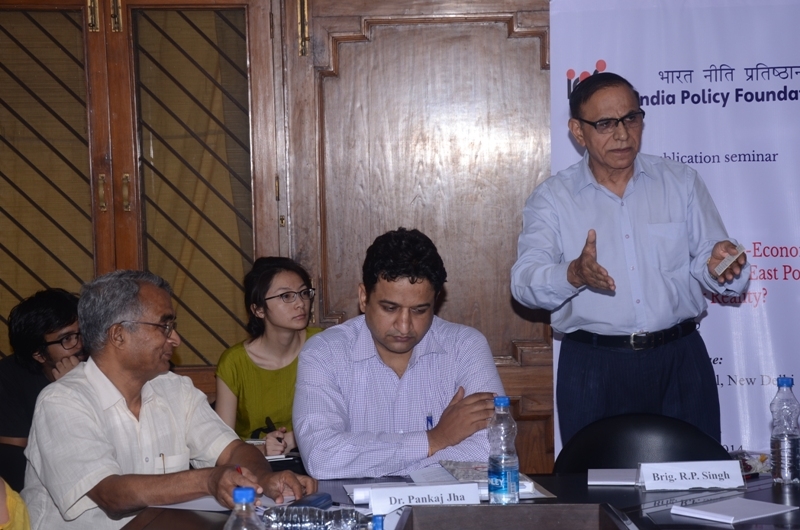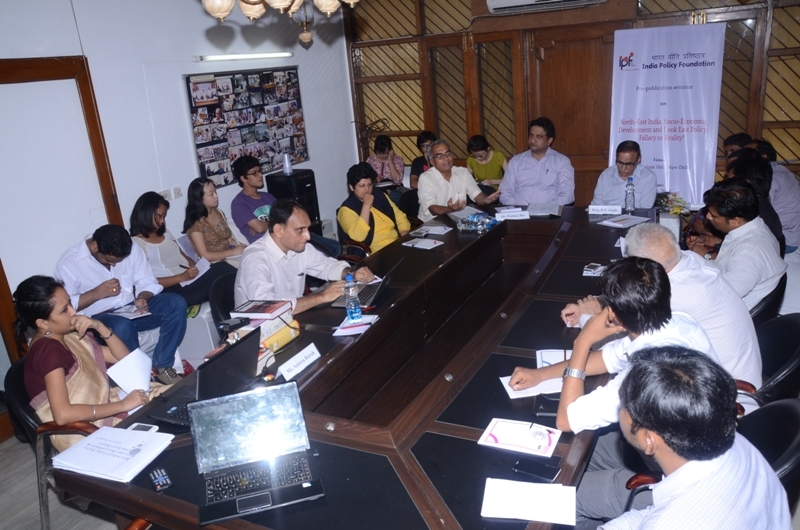North-East India, Economic Development and Look East Policy: Fallacy or Reality?
Total Views |

July 5, 2014, IPF Seminar Hall
Speakers: Brig. R. P. Singh, defense expert, Dr. Pankaj Jha, Senior Fellow of Indian Council of Presentation - Antora Borah, Senior Fellow, IPF.
People of the North East must be integrated and the sense of alienation must be done away from the people of the region. 'People of the region are Indians and must not be treated like aliens' was the sentiment. The entire region needs not only attention of the government but people of the mainland also need to be little more sensitive towards them. The debate on the Look East Policy and socio economic development of North East presented various aspect of non delivery of policy. Talks were also focused on the diplomatic exercises to counter China for its Look East Policy. Social and cultural contours are equally important along with the economic aspect.
Inaugurating the debate, Prof Shardendhu Mukherjee outlined that the region is very delicate part of the country but due to its geographical conditions, it is disconnected from the main land of the development. There is cultural and religious boundary but with certain fault line. Former prime minister of India Atal Bihari Vajpaye issued a notification that 10 per cent of the budget should be spent on research on north east which was implemented but later on it has not been reported properly. IPF research fellow Antora Borah gave a research presentation ‘North East India, Economic Development and Look East Policy: Fallacy or Reality? She covered most of the issue in her presentation for the development of region that included indulgence with Bangladesh in diplomatic relations to get transit facility to make the region more accessible. She also suggested the region can be developed as the rice bowl for the country and it can also become international education hub. Handloom, bamboo industry minerals and other things can be exploited but there is a need to integrate people of North East first. She puts few questions for the house which were very significant such as whether it is pertinent to think how one can open the door to the East? Is market connection the only one by which one can establish the historical continuities with east neighbours? Will this market connection really be an economic as well as cultural hub for the people of the N.E region? Whether the new imaginary of North-East will have direct connection with the eastern neighbors without depending on Delhi? Is it only the economic development will curb the problem of insurgency in the region. Will there be any security threat from neighbouring countries? Will the policy enhance the chance of illegal immigration to N.E.India? Whether the future ethnoscope of the region is expected to be shot with many more ethnic conflicts? Is there a chance of N.E. to drift away from India?
Brigadier R P Singh took entirely different view on the Look East Policy. He outlined the region for adopting Look East Policy as the country was in debt with foreign exchange crisis. On the other hand he quipped by saying that India has always been looking east right from the time of Lord Buddha. Brigadiar Singh said that there are two kinds of Look East Policy one beyond borders and the other within the boarder. Now there is a need to understand that total 4 crore population of the northeastern region need to be integrated. Out of this 4 crore, 3 crore are Assamees. So highly spread and vast region should be provided with all development tools. But there is a need to understand that if the region has to be developed, local people must be encouraged for setting up industry to other development activities. It is critical to involve local population and influential people to implement development policy in North East like Panchayti Raj System. For the Look East Policy beyond boundaries, there are certain threats and blocks from China for the country. It is for the country to tab such countries which can be of good help to India vis e vis China like Taiwan, Vieatnam, Thailand, Cambodia and Laos etc.

While another speaker Pankaj Jha, fellow ICWA, said that Look East Policy is quite old now but the discussion is on for Enhanced Look East Policy. Northeastern region must be integrated with the bordering country. We must develop better relations with smaller countries and specially Myanmar. The region has high diplomatic importance for India and offers straight integration with many countries in ASEAN. In the knowledge society, we should focus on promoting research in NE universities and support the scholar and student exchange programme and researches with the critically important nations. Rangoon University must have exchange programme with India. But the most important issue that he raised was the issue of Chinese spies being arrested frequently that is very alarming.
Seminar was attended by eminent Think Tank experts, academics, North East students and other sections of the society.